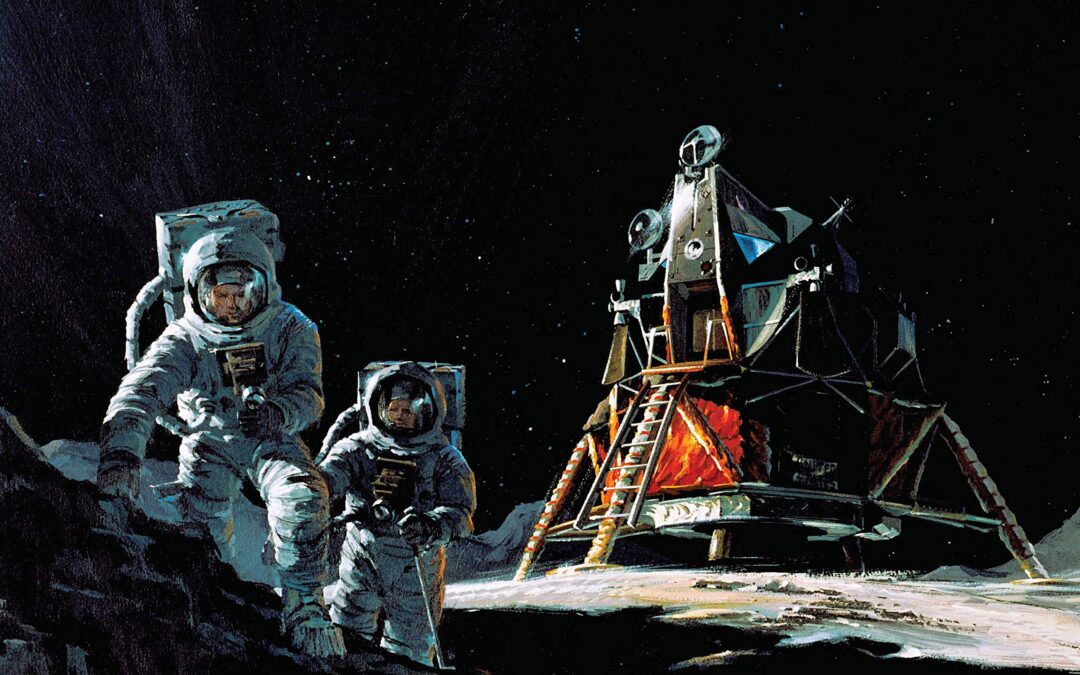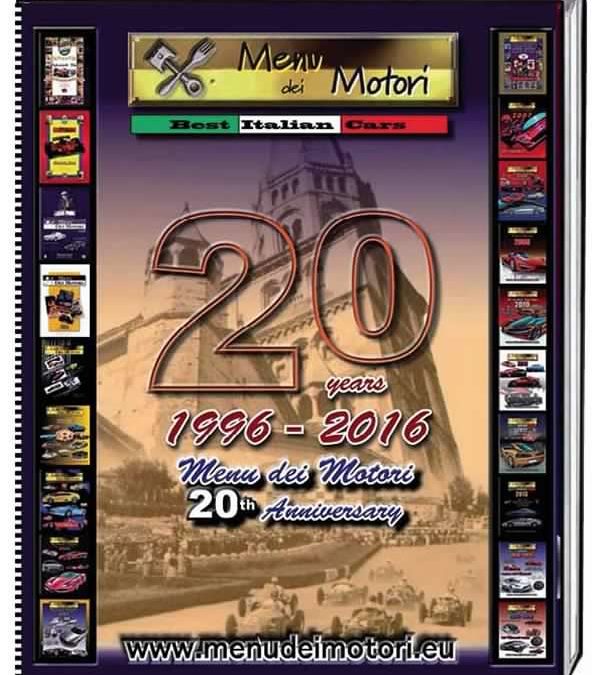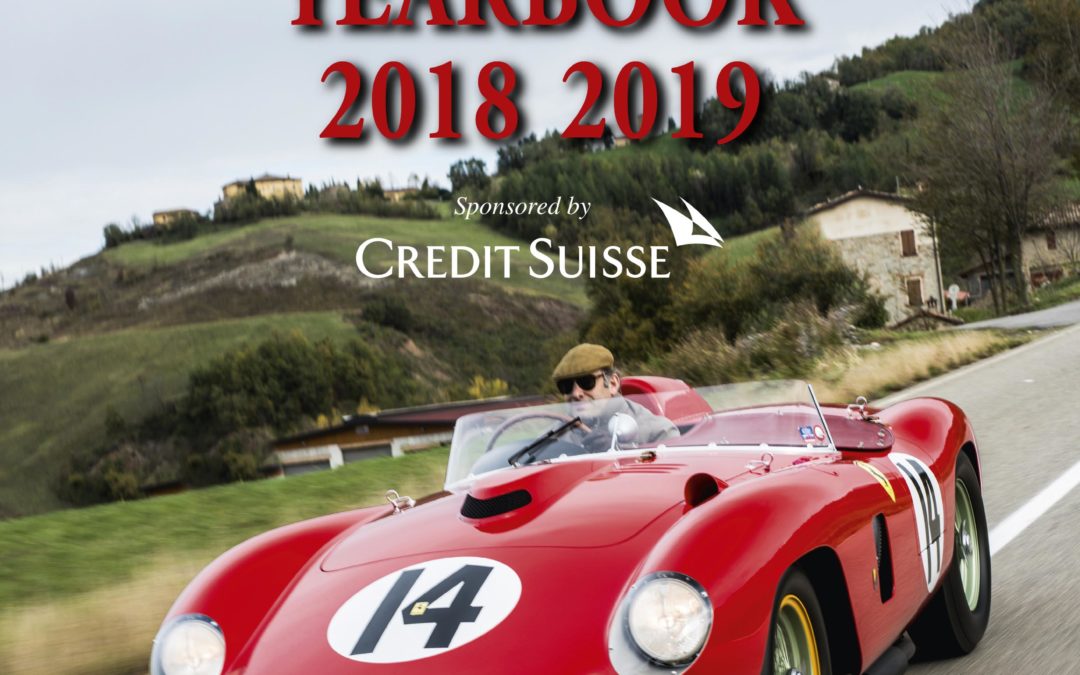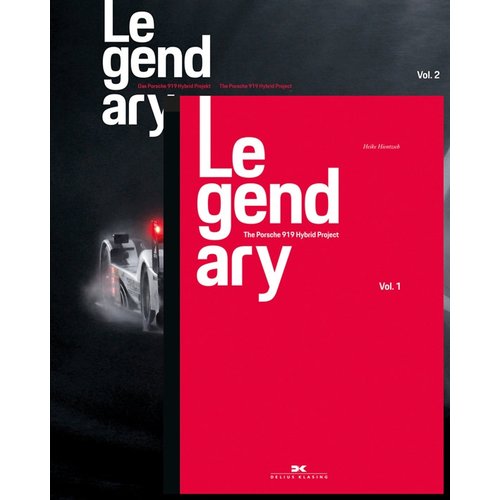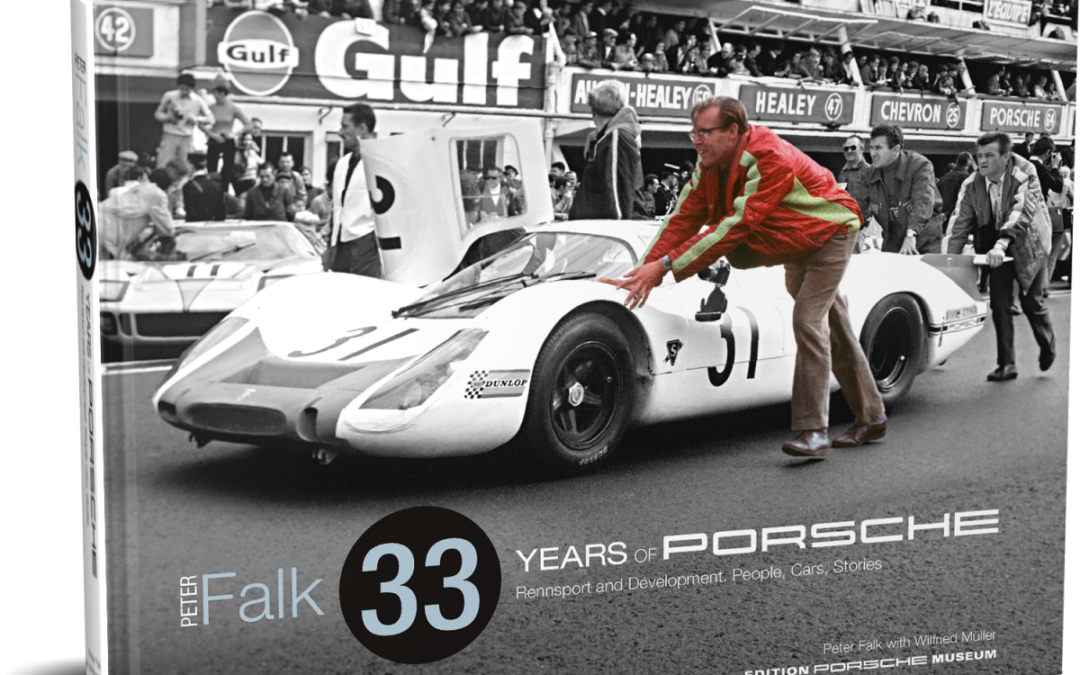
This edition of the book is limited to only 150 numbered copies, contains a hand signature of Peter Falk and comes in a luxury linen slip case.
Peter Falk and Porsche, 33 years of passion and devotion: As their race director and one of the leading figures in their experimental department, Peter Falk contributed significantly to the character of the sports cars from Stuttgart-Zuffenhausen – both on the race track and on the road.
From the first 901 right through to the very last air-cooled Type 993, every Porsche 911 bears the signature of Peter Falk. He joined the company in 1959 and quickly rose through the ranks to head various testing departments. In the mid-sixties, Falk also took over the tactical and technical leadership of the factory’s “Rennsport” team. In 1981, he was appointed as race director and led Porsche throughout its most successful era of competition. “His” team won at Le Mans, became World Sports Car Champions, conquered the Paris-Dakar Rally, and was victorious in Formula 1 with the TAG Turbo engine.
In this book, Peter Falk tells of his years with Porsche. A highly respected person in the world of engineering, he relates how it all began at Porsche – when race drivers and engineers huddled together in a shepherd’s hut at Weissach to discuss suspensions, what the Porsche crew experienced during endless testing adventures in both the Arctic Circle and the Sahara, how the race cars at Le Mans roared to the start over country roads, and how a test drive with a Porsche 908 almost cost him his life. He shares his views on every Porsche race car, from the 904 Carrera GTS to the 962C, and describes the race drivers who competed during his reign: Hans Herrmann, Jacky Ickx, Vic Elford, Derek Bell, Hans-Joachim Stuck and Jochen Mass to name just a few. Falk provides a good, long look into the inner workings of Porsche.
Peter Falk shared his personal Porsche stories and fascinating insights with the author Wilfried Müller. The images in this book come from Peter Falk’s private collection, from the Porsche Historical Archive in Stuttgart-Zuffenhausen, and from the vast cache at McKlein Photography. Along with the contributions from former colleagues and race drivers, these images and stories give an in-depth portrayal of Peter Falk’s 33 years with Porsche.
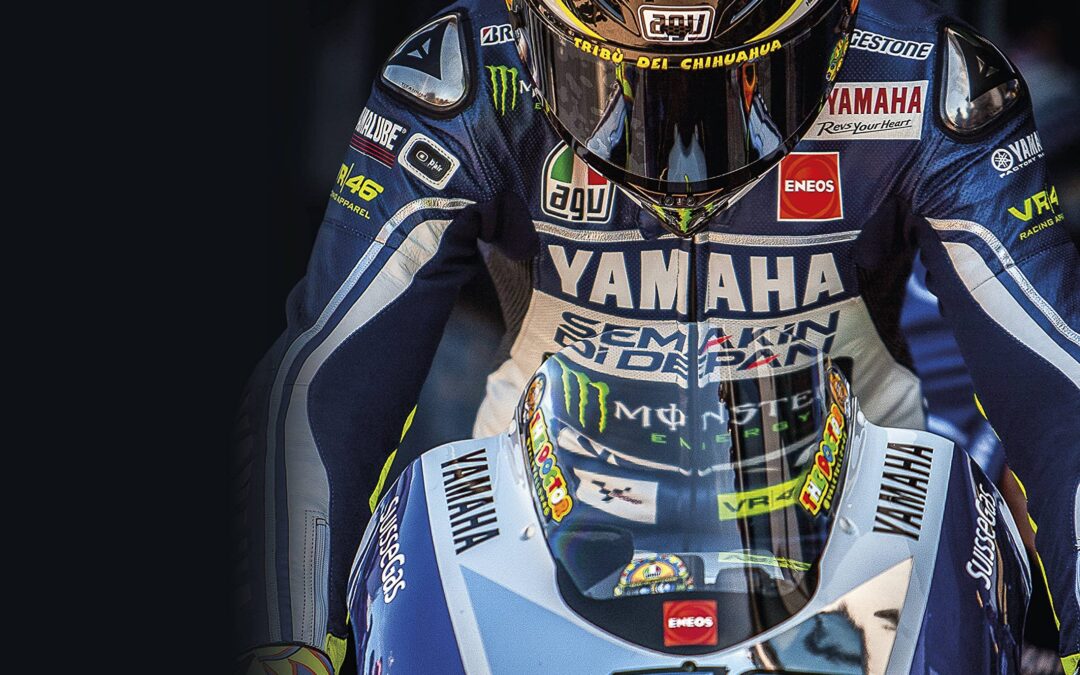
Valentino Rossi’s retirement brings down the curtain on an incredible career in the MotoGP motorcycle world championships.
With his nine titles, including seven in the premier class, he is widely regarded as the greatest motorcycle racer ever, and his 26 seasons of Grand Prix racing make him unique across both motorcycling and Formula 1. Rossi has been captivating fans since he won his first Grand Prix at the age of 17 and even in his final season, at the age of 42, he has been riding faster than ever.
In Valentino Rossi: All His Races, by top journalist Mat Oxley, each and every one of these races comes under the microscope, complete with perspectives about Rossi’s achievements, the controversies, his character, and analysis of his bikes. This is a Valentino Rossi book like no other, with photos by Henk Keulemans, who was shooting grand prix racing when Rossi’s father Graziano was winning races.
- Early days, from karting and minimoto bikes to a first GP win, on a 125 Aprilia in the 1996 Czech GP, then onwards to claim the 125cc world title in 1997.
- Moving up to the 250cc class in 1998 brought four consecutive end-of-season wins riding for Aprilia, followed by a decisive title in 1999 with nine victories.
- Grabbed by Honda to race its super-successful NSR500, Rossi graduated to the ‘class of kings’ for 2000, almost becoming champion that season — but the following year he sealed
- MotoGP, for 990cc four-stroke bikes, took over and Rossi immediately reigned supreme aboard his Honda RC211V, securing back-to-back titles in 2002 and 2003, before a surprise departure to uncompetitive Yamaha.
- Rossi rates his first year with Yamaha, 2004, as his best: defying expectation, he won first time out on the YZR-M1 and took a fourth successive title with nine wins.
- In six more seasons with Yamaha, 2005–10, Rossi collected three more championship crowns, his 2008 success especially sweet because it involved a fightback after two leaner years.
- Rossi’s move to Ducati looked to be an appetising all-Italian prospect but his two winless seasons there, 2011 and 2012, were disastrous.
- A return to Yamaha never quite recaptured his greatest glories, but Rossi was championship runner-up three times and came very close to another title in 2015.
Beautifully designed and comprehensively illustrated, this book is the complete record of Valentino Rossi’s remarkable career in motorcycle racing.
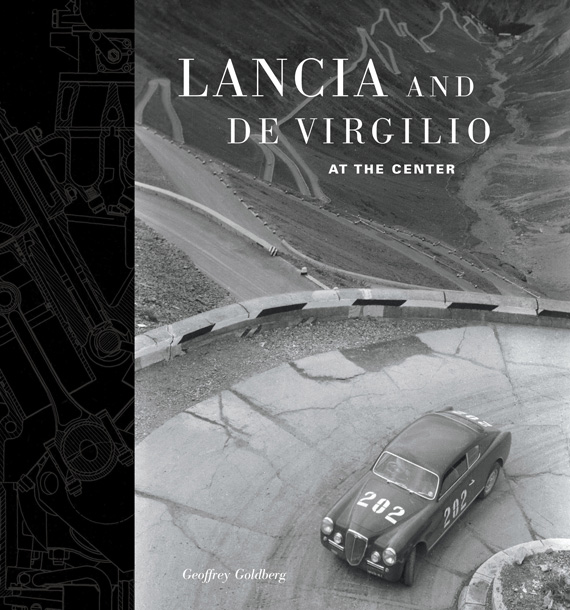
In the years following the Second World War, Lancia was the most innovative automotive company in Italy, if not in the world. The Lancia cars were technically advanced, with an elegant and competitive design on the track. For more than four decades, Francesco de Virgilio was one of the primary figures in the history of Lancia. De Virgilio entered the company as a young engineer in 1939, becoming a member of the Lancia family, when he married the niece of the founder Vincenzo Lancia, in 1947. In Lancia and de Virgilio, the author Geoffrey Goldberg examines the life and career of De Virgilio from multiple perspectives. Drawing on a large number of original documents, technical drawings and photographs from the archives of the De Virgilio family, Goldberg reveals the essential role of De Virgilio in the projects that defined Lancia during its best years in the 1940s and 50s. These include the development of the first production V6 engine, launching and improvement of the Lancia Aurelia, and the management of the short racing program of the company, which produced the classic D50 Formula One car. In addition to engineering and competitions, De Virgilio was directly involved in the events that effected the management and position of Lancia in the Italian automotive industry. In 1955, the family released its control of the company, leading to its eventual acquisition by Fiat in 1969. Through all these upheavals, De Virgilio continued to experiment and innovate, working on multiple projects, from diesel engines for trucks to the first versions of the rally car Stratos in the 1970s. Whatever the assignment, his persistent search for excellence remained a constant element defining Lancia, up to his departure from the company in 1975. Despite his technical successes and his popularity within the company, De Virgil’s contributions have been widely neglected to date.
Produced with the support of the RevS Institute for Automotive Research, Lancia and de Virgilio is the product of more than six years of meticulous research. The book is illustrated with hundreds of unpublished photographs that depict the images of Francesco de Virgilio at work, on the track and at home with his family, as well as dozens of drawings, projects and other finds. In addition to this abundance of details and information, the book, also captures the vibrant spirit of Italian, culture and society during the post-war period. Lancia and de Virgilio provides unique insight into both automotive and social history. The book was greatly appreciated by enthusiasts: it won several awards, including the Cugnot Award of the Society of Auto Historians for the best book of the year. It was also reviewed by the New York Times and the Republic, a rather exceptional event for a book on a company and its history already seventy years in the past.
This limited edition reprint is an opportunity not to be missed for those who did not secure the first edition in 2014.
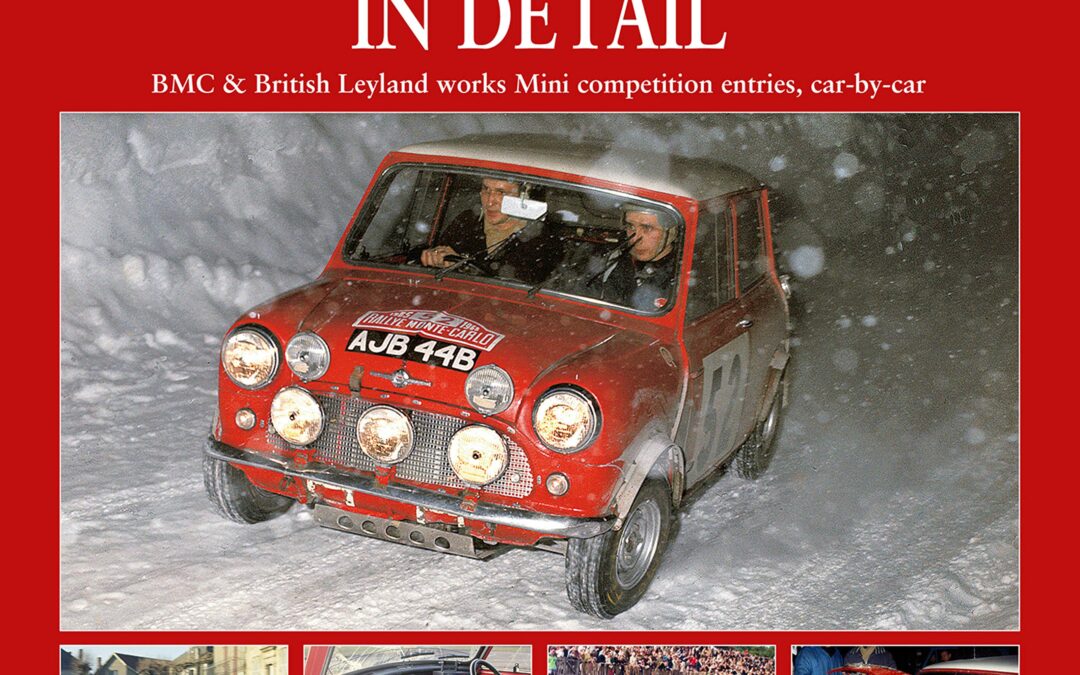
The works Minis had a long and distinguished competition history between 1959 and 1970, when British Leyland bosses closed the Abingdon Competition Department. The car started its competition career chasing class awards with the diminutive 850cc Mini, but once race car designer John Cooper persuaded BMC that they should build a hot version, the Mini Cooper was born and things moved up a gear.
With the introduction of the Mini Cooper S, the car soon became a world beater. Winning the 1964 Monte Carlo Rally in the hands of Paddy Hopkirk was a watershed moment which the Abingdon team repeated three times. During that 11-year period, 77 works Minis were built, competing in more than 300 events, most of them international rallies. The 1969 season, when the works Minis went racing, is also covered, along with the rallycross events.
Works Minis in Detail covers each one of those 77 cars which, in their distinctive red and white paintwork, were a force be reckoned with wherever they competed. Build details of every car are provided, drawn from factory build sheets, with information also on when cars were reshelled and identities swapped. The details of the events entered and the drivers are the result of analysing hundreds of contemporary race and rally reports.
The result is the most in-depth study of the works Minis ever published, made possible by years of research by Robert Young, a lifelong Mini enthusiast. As the Mini Cooper Register’s ex-works registrar, club chairman and for many years archivist, he is well placed to write with authority. A proud owner himself, he has intimate knowledge of the little red cars.
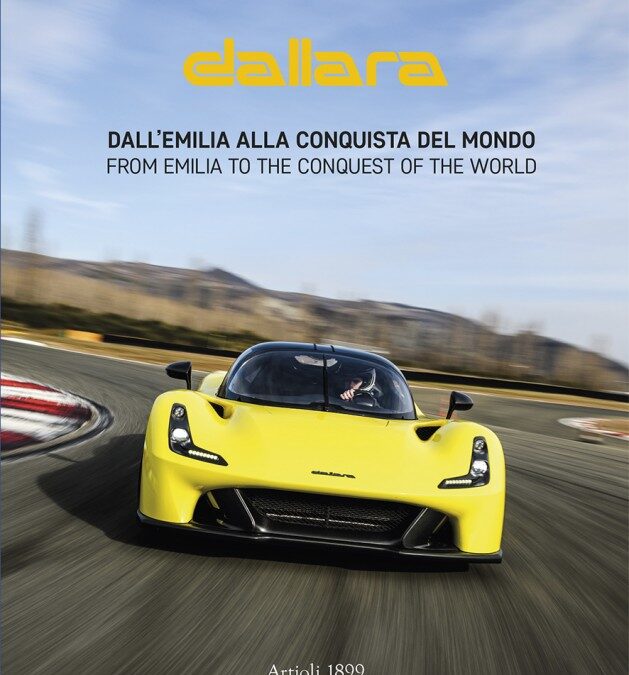
Before he was thirty, the engineer Giampaolo Dallara designed the Lamborghini Miura, a supercar that came from another planet, and one that caused its entire global competition to age overnight. More recently, his cars have won nineteen editions of the Indianapolis 500, historically the most important race in the world. And then another surprise, the presentation of the Dallara Stradale, a fascinating 400 hp supercar produced in series in the multi-faceted factory of Varano de’ Melegari, in the province of Parma.
These three commitments alone would be sufficient for a vast book on the activity of Giampaolo Dallara, who however has never ceased to broaden his own interests, based on the passion for motor sport and the evolution of technology. In 320 pages we describe how this extraordinary character, of great technical ability and of equally remarkable human depth, has evolved from his first job in Ferrari’s racing department, to the growth that led him to become the most important manufacturer of racing cars in the world, starting from a small ‘factory’, which over the years has been transformed into a company with over 700 employees.
This miracle has come about due to the undoubted technical ability of the engineer from Varano, but also due to his personality, an exceptional mix of pragmatism and simplicity, which can be summed up in the motto of the company created in 1972: ‘The continuous search for excellence’.
A commitment that has allowed him to add to his ‘core’ business activity, the design of road and racing cars for some of the world’s top companies: Ferrari, Alfa Romeo, Bugatti, Maserati, Audi, Toyota, Honda and KTM.
But Dallara has never ceased to amaze: in the autumn of 2018 he inaugurated the ‘Dallara Academy’: a commitment desired and financed by the engineer himself, materialized in a new, modern structure that, together with the vast ‘museum’ with all the Dallara cars ever built, includes classrooms for educational purposes for middle and high school students, up to a Master’s degree in ‘Racing Car Design’.
A great engineer, a great Italian and a perfect Emilian!

The US Navy’s fleet of aircraft carriers are at the heart of global American military force. With nuclear-powered oceanic range, complements of nearly 5,000 crew, and typically carrying more than 70 combat aircraft, US carriers can remain on station for months, delivering aerial combat strikes on distant targets around the clock.
The Haynes US Super Carrier Operations Manual offers unrivaled insights into understanding how a modern US super carrier is operated. The US Navy has given Haynes author Chris McNab and photographer Patrick Bunce official clearance to spend time at sea on one of its ‘Nimitz’ or ‘Gerald R. Ford’ class super carriers.
During the visit Chris conducted interviews with key personnel of all major departments, including flight-deck crew, aviators, ordnance officers, engineers, logisticians, operations crew and the captain; while Patrick photographed life above and below decks, with a special focus on the engineering side of carrier aviation often not covered in other publications.
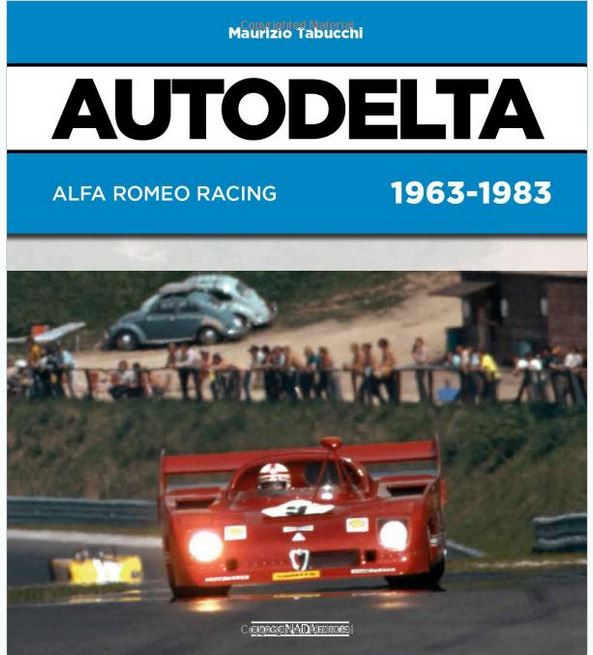
The Autodelta story, Alfa Romeo’s more or less official racing department between 1963 and 1983. A tale of unforgettable victories, of two titles conquered in the World Championship for Marques, but also one of scalding defeats. Great names in the history of motorsport raced in the colours of the team born in the province of Udine and nurtured at Settimo Milanese including Ignazio Giunti, Nino Vaccarella, Andrea de Adamich and Toine Hezemans. All drivers who competed – under the aegis of the incomparable Carlo Chiti – at the wheel of unforgettable cars such as the Giulia TZ, the GTA, the 33 in its various guises, the Alfetta GT rally cars and naturally the less successful Formula 1 machines. All this is revived in a book constructed around painstaking research and illustrated with hundreds of photographs, many of which previously unpublished

Just before midnight on May 14, 1914, a ferryboat departed from Weehawken, New Jersey and chugged along in the darkness across the Hudson River to Manhattan. On board was a tired-looking rider with an equally tired-looking motorcycle. The boat landed at ten minutes after midnight and there to greet him were representatives from the Federation of American Motorcyclists, the nation’s major motorcycle sanctioning organization. What they knew was that this rider, Erwin G. Baker, had just completed the fastest transcontinental trip in American history.
Baker’s journey of 3,497 miles had taken him 11 ½ days. And, oh, what an incredible 11 ½ days it was! After leaving San Diego on May 3rd he rode coast to coast, averaging only four hours sleep each night. Danger seemed to await him at every turn. In the Arizona desert he ran out of gas and had to push his motorcycle five miles in the sand in 119-degree heat. When he got to New Mexico he hit some rainy weather, which turned the historic Santa Fe Trail into a deep mud bog. He suffered six flat tires once on the same day, which he had to repair with the tools he carried with him, and in Pennsylvania he rode 232 miles of mud in a steady downpour. Despite all this, Baker continued east as fast as he could legally go. When he landed on Manhattan, he had smashed the current record holder’s long-standing record by more than nine days. His amazing journey concluded at the Hotel Astor in New York City where he was met by journalists wanting to get the story. One shouted out that he had “shot across the country like a cannon ball.” He was forever more Cannon Ball Baker!
In 2011, Don Emde, a former winner of the prestigious Daytona 200 motorcycle race and 1999 Inductee to the Motorcycle Hall of Fame, embarked on a multi-year project to understand the riding conditions and retrace the route that Cannon Ball Baker had taken in 1914. Using modern day computer search tools, GPS, and current adventure-style motorcycles, he and an assistant, Joe Colombero, logged numerous miles in the California and Arizona desert to work out what remains of the dirt roads that Baker had ridden. Their research ultimately took them on a ride all the way to New York City on the same route that Baker had taken. Their discoveries and difficulties is a great story in itself. Finally, in 2014, Emde led a group of 30 motorcyclists on a celebration ride from San Diego to New York City, just as Baker had done a century before. The group departed on May 3rd—100 years to the minute from when Cannon Ball had left San Diego—and arrived in New York just as he had on May 14th.
This is the story of three epic motorcycle rides across America.

Along with three fellow motor racing enthusiasts, Steve Matchett – Formula 1 world champion mechanic; accomplished television broadcaster; and best-selling author – is trapped overnight in New York: a fogbound JFK airport. With no sign of the weather improving, talk between the stranded passengers inevitably turns to Formula 1. During the course of their cloistered night, with conversation fueled by regular trips to the departure lounge bar, our protagonists draw on Matchett’s encyclopedic knowledge of grand prix engineering, his easy familiarity with F1 paddock life, to piece together the perfect dream-team Formula 1 race car.By use of his enviable signature talent, his ability to explain complex issues using straightforward, uncomplicated language, Steve Matchett shows us how the various F1 teams have arrived at their current state-of-the-art designs – lays out exactly how a championship winning grand prix car is assembled.Originally published by Orion (of London) in 2004, The Chariot Makers is Steve Matchett’s third book. Along with Life in the Fast Lane, and The Mechanic’s Tale, this compelling, insightful story – its warm text reading as a novel – forms the final installment of the author’s entertaining, timeless, and highly acclaimed Formula 1 trilogy.
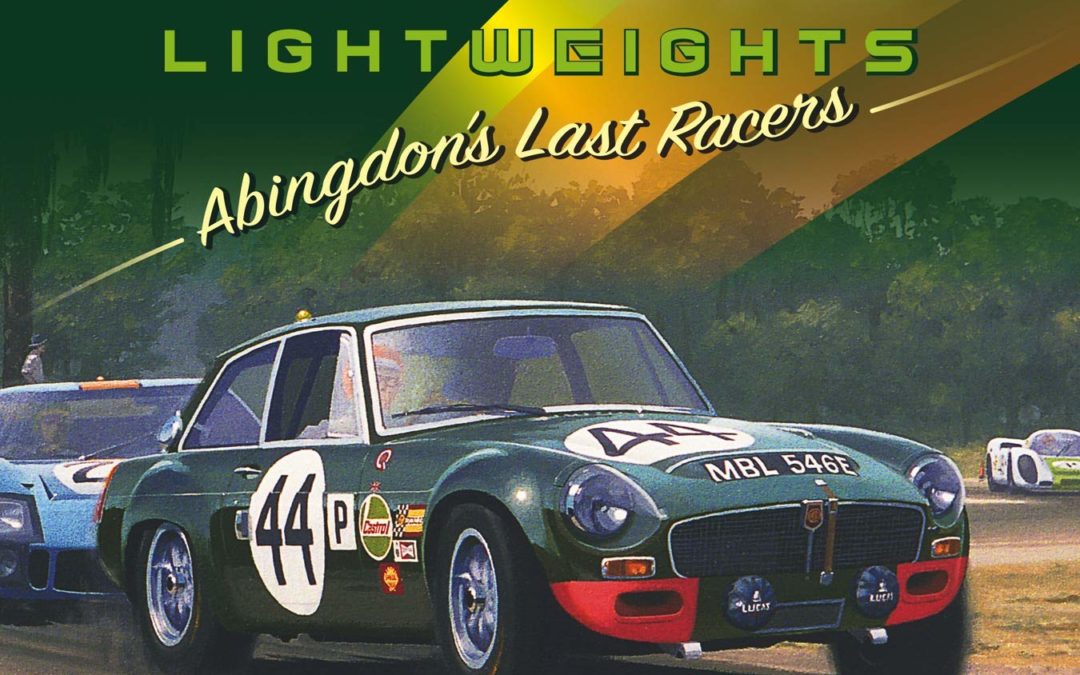
A fascinating insight into the production and career of the MGC GTS lightweights, this well-researched text is generously illustrated with rare photographs, race programs, and original artwork.
In early 1968 a works competition MGC GTS scored the MG Car Company’s best ever result at the Sebring 12-hour race, finishing in tenth position. Buoyed by this success a second car was built, with both entered on the Marathon de la Route but without success. Closure of MG Competitions Department at Abingdon was not far off, however the team gallantly prepared both cars for their final race in 1969. Under the banner of the American importer the newer car finished in fifteenth position.
The MGC GTS Lightweights covers the development of the production road car, its conception, compromised design and subsequent failure to attract loyal MG customers. This is followed by an in-depth technical analysis of the development, construction and build of the MGC GTS. Specific attention is given to the specialised components utilised, particular emphasis placed on the unique aluminium bodyshell that for the first time is laid bare. The competition history and race results are comprehensively covered, and lastly the subsequent fall from grace and rediscovery of these last and much loved MG competition cars to emerge from Abingdon.
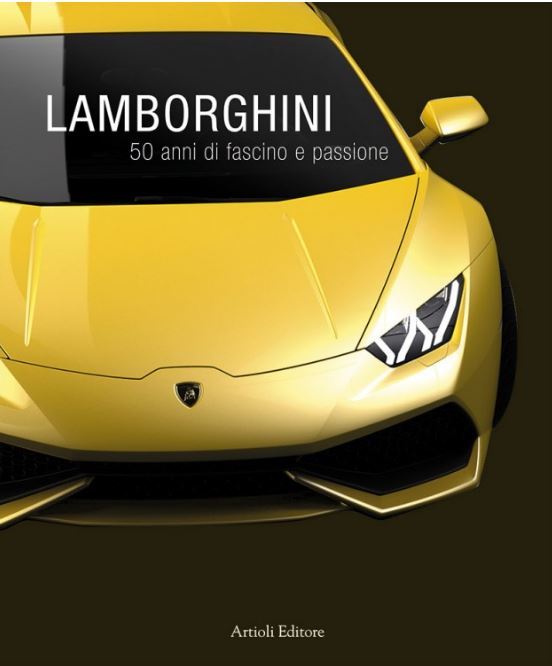
Lamborghini has always produced cars which evoke emotions. Some of these designs are are reflected in the pages of this volume in a semi chronological order.
The book opens with the latest successful events, exploring the technological leadership of the Brand, which is famous for its V12 and V10 engines (the key to the outstanding performance of the current Aventador and Huracán), but also for its new departments for processing of carbon fibres.
This investment has enabled Lamborghini to become a leader in series production and to stand out for this sophisticated and complex industrial process.
From the preface by Daniele Buzzonetti
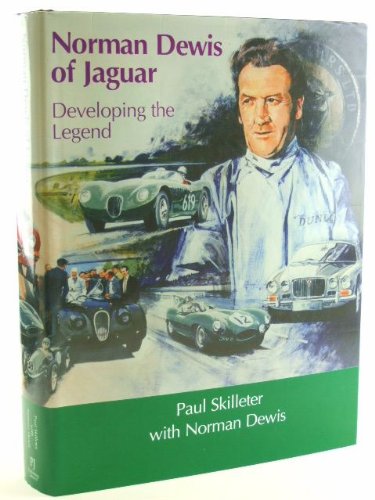
SIGNED BY NORMAN DEWIS
This is a story both of personal achievement and of a heroic period in Jaguar’s history. In a career spanning 33 years at Jaguar, Norman Dewis tested and developed a remarkable series of cars including:■ C-type ■ D-type ■ XK 140/150 ■ 2.4/3.4 and Mk 2 saloons ■ Mk VII/Mk VIIM ■ E-type ■ XJ13 ■ XJ/XJ-S ■ XJ40
Plus, he rode with Stirling Moss in a C-type in the 1952 Mille Miglia, drove a 190mph works D-type in the highly dramatic 1955 Le Mans, raced in the Goodwood 9 Hours, and set an amazing 173mph production car record at Jabbeke in Belgium with an XK 120. Completing over a million test miles at 100mph-plus average, Norman also played a crucial role developing the revolutionary Dunlop disc brake, and survived high-speed crashes and rollovers in the days before seat-belts – and without ever breaking a single bone.
This book is automatically also a development history of Jaguar, with a wealth of new technical details of how key models were evolved.Filled with personal insights and fascinating technical detail, this book tells the unique story of a great Jaguar character and the equally great cars he worked with.
Norman did not, of course, work in isolation and his recollections bring to life the unique team which made Jaguar great – company founder Sir William Lyons, engineering director Bill Heynes, development engineer Bob Knight, aerodynamicist Malcolm Sayer, and service department and race team manager Lofty England. These and many more become real people as Norman tells of his every-day involvement with them.
Norman’s proudest moment in the last decade was receiving the MBE in 2015, a fitting recognition of his achievements for Jaguar and the British motor industry – for both of which he remains a great ambassador
If anyone was at the heart of Jaguar during perhaps its most remarkable decades of achievement, it was Norman Dewis. Read this book and you will absorb the authentic flavour of Jaguar in Coventry and fully appreciate the achievements of a remarkable man.
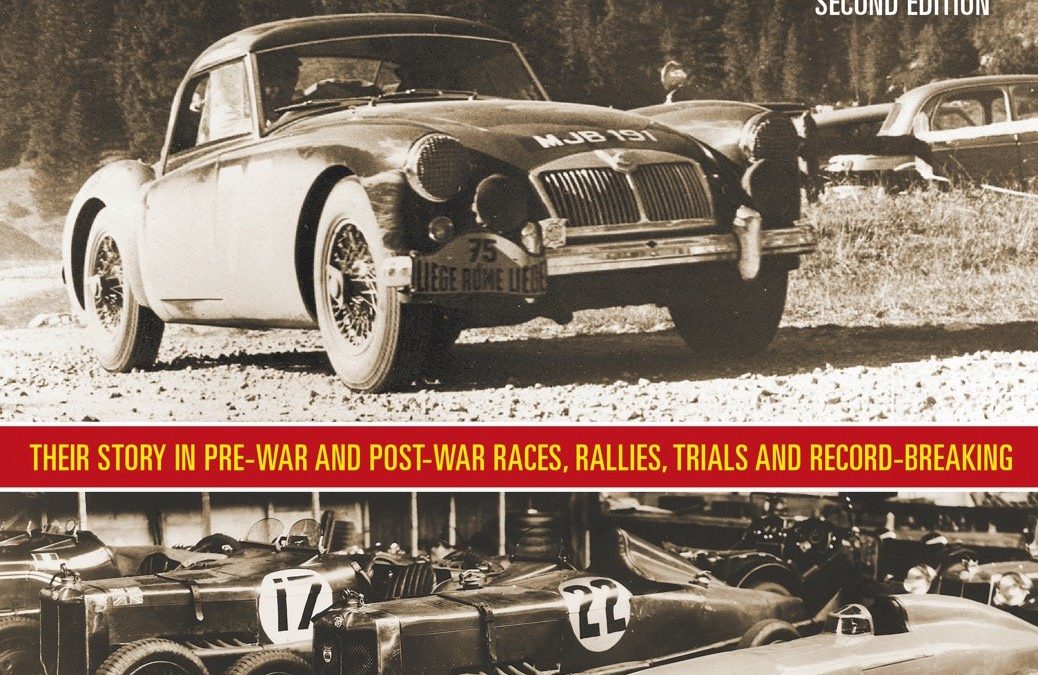
A Classic Reprint. The Works MGs is the authoritative story of all the MGs prepared and entered by the MG Car Company and its successors in international competition from the 1920s to the late 1960s.
The book covers prewar racing and record-breaking attempts, as well as the postwar achievements of the works cars entered in races and rallies by the BMC Competitions Department. The authors, who both worked with MG, bring together their own experiences, extensive research, and the recollections of former colleagues to produce a unique insight into this important aspect of British motorsport history.

My Father The Car: Memoirs of my Life with Studebaker features rare memorabilia and photos from the Studebaker Corporation’s Advertising & Public Relations department along with Mr. Chapman’s personal stories and photos. This 7 x 10 inch, 144-page edition includes 48 full color pages with a soft bound, color cover. When Stu Chapman left his position of Director of Advertising and Public Relations for Studebaker in 1966, he inherited virtually all of the company’s memorabilia from the 1960s. This material, coupled with a thousand memories had left him as an effective spokesperson for Studebaker. Now Chapman has recorded all of these memories for posterity in his new book, My Father The Car: Memoirs of my Life with Studebaker. Studebaker history buffs and historic car fans alike, will appreciate all the previously untold tidbits of information offered in this new edition. A must have for any collector’s or enthusiast’s library.
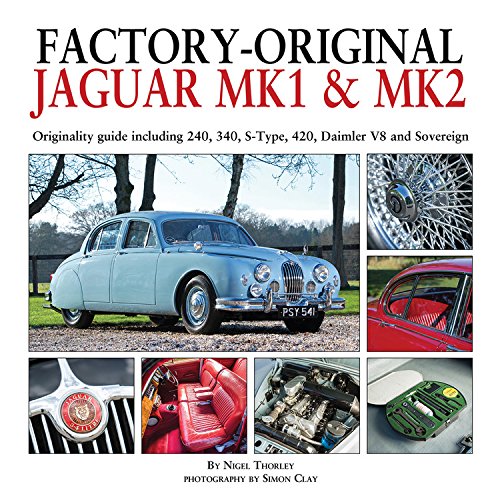
Originality guide including 240, 340, S-Type, 420, Daimler V8 and Sovereign
Jaguar founder Sir William Lyons had a hit on his hands when he launched the “compact” 2.4 liter sports saloon in 1956. A year later those wanting more thrills were offered the 120mph 3.4 Liter. Both were replaced in 1960 by the Mk2 models, which added a 3.8 liter, and from there on, the range was developed and expanded with the long-booted S-type of 1964, the 4.2 liter 420 of 1967, and the final 240/340 models of 1968.
Alongside there were the Daimler V8 and Sovereign models. The Mk1 and Mk2 and their derivatives have been heading the list of desirable classic cars for many years, and more and more worn-out, semi-derelict examples are being dragged out of garages and barns to be restored.
For those seeking originality in a restoration, or considering the purchase of a car, or even noting points of originality or otherwise in a car they already own, Factory-Original Jaguar Mk1 & Mk2 provides the comprehensive guide to factory specifications, equipment and finishes in all departments.
It covers engine and transmission, body panels, interior and exterior trim, electrics, dashboard, instruments, switches and controls, lamps, under the hood components, paint and trim colors – in fact, everything right down to the tool kit, from the beginning of production to the end.
The text is accompanied by some 300 specially commissioned color photographs of outstanding examples of the cars, enabling the reader to view every model and variant in considerable detail.
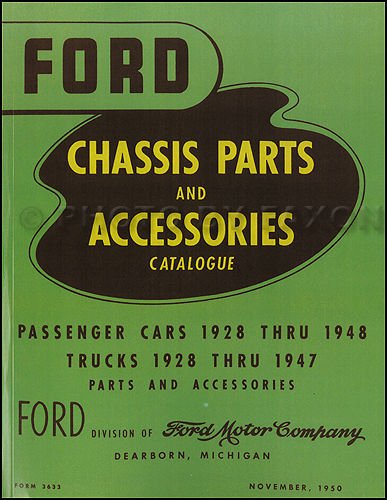
This is a high quality reproduction of the factory parts book known to collectors as the “Green Bible” of vintage Ford parts. It was written by Ford for the parts departments at their dealerships. You will find the original part numbers, which are still useful today because most parts vendors still use the original manufacturer’s numbers to keep track of their parts. Use this book to make your search for parts both quicker and easier. The illustrations in the book will help you identify parts, and the exploded views can aid you with the assembly or disassembly of some parts of the vehicle. You will find parts for your entire vehicle except for the body, including: wheels, hubs, drums, brakes, front axle, steering gear, rear axle, coupling shaft, frame, muffler, springs, engine, transmission, clutch, radiator, fuel system, generator, battery, starting motor, distributor, ignition coil, lamps & wiring, fenders, hood, windshield wiper, shock absorbers, standard parts, bumpers, and accessories. You will also find specifications for and dimensions of most parts listed. Find out if the parts on your car and the parts you are buying are original and complete. Covers all Ford Model A & AA, V8 & 4-cylinder Cars, Pickup & Commercial Truck models, and even school buses. This manual works well as a model year interchange manual!!! There are exploded view illustrations throughout this 802 page book. Buy now for the best parts book for your vintage Ford.




